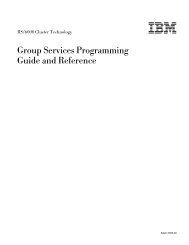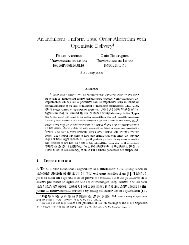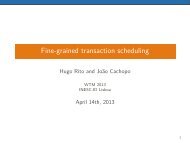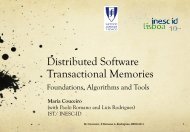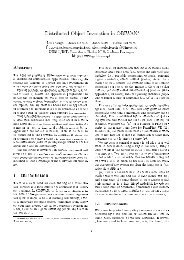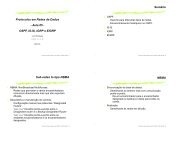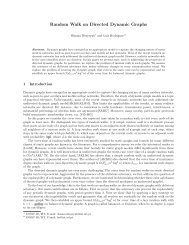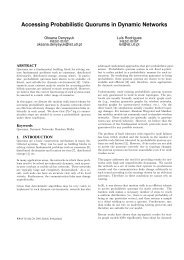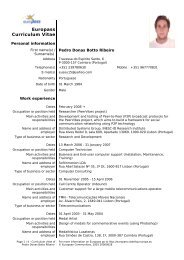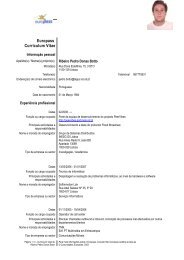Selfish and Malicious Behavior in Delay-Tolerant Networks
Selfish and Malicious Behavior in Delay-Tolerant Networks
Selfish and Malicious Behavior in Delay-Tolerant Networks
Create successful ePaper yourself
Turn your PDF publications into a flip-book with our unique Google optimized e-Paper software.
as different protocols perform better or worse depend<strong>in</strong>g on the type of misbehavior. This<br />
suggests the need for further research <strong>in</strong> the area.<br />
The paper is organized as follows. Section 2 presents the rout<strong>in</strong>g protocols considered<br />
<strong>in</strong> the paper <strong>and</strong> discusses related work. Section 3 presents the types of misbehavior<br />
studied. Section 4 describes the simulation model. Section 5 presents the evaluation of DTN<br />
rout<strong>in</strong>g protocols with a variable number of misbehav<strong>in</strong>g nodes. Section 6 concludes the<br />
paper.<br />
2. DTN Rout<strong>in</strong>g Protocols <strong>and</strong> Related Work<br />
Direct Delivery [6] <strong>and</strong> First Contact [7] are s<strong>in</strong>gle copy DTN rout<strong>in</strong>g protocols where only<br />
one copy of each message exists <strong>in</strong> the network. In Direct Delivery, the message is kept <strong>in</strong><br />
the source <strong>and</strong> delivered only to the f<strong>in</strong>al dest<strong>in</strong>ation, if the nodes meet. In First Contact, the<br />
message is forwarded to the first node encountered <strong>and</strong> deleted. The message is forwarded<br />
until it reaches the <strong>in</strong>tended dest<strong>in</strong>ation.<br />
The Epidemic [8] rout<strong>in</strong>g protocol is an unlimited-copy rout<strong>in</strong>g protocol as nodes may<br />
forward messages to any node they come <strong>in</strong> contact with. When two nodes come <strong>in</strong>to<br />
communication range, they exchange a summary vector conta<strong>in</strong><strong>in</strong>g <strong>in</strong>formation about<br />
messages that they have not yet seen. The receiv<strong>in</strong>g node decides whether it accepts the<br />
message or not. This decision is taken, for example by not carry<strong>in</strong>g messages for a certa<strong>in</strong><br />
dest<strong>in</strong>ation node, or of a certa<strong>in</strong> size. The buffer size <strong>and</strong> hop count field limit the amount<br />
of resources consumed through Epidemic Rout<strong>in</strong>g.<br />
In many real environments, encounters between nodes are not r<strong>and</strong>om, but follow a<br />
predictable pattern. Mobile Ubiquitous LAN Extensions (MULEs) [9] are mobile agents<br />
(vehicles or animals) that when <strong>in</strong> close range pick, buffer <strong>and</strong> drop off data, carry<strong>in</strong>g data<br />
between remote locations. To exemplify a pattern, the Data MULEs <strong>in</strong> [10], meet with<br />
higher probability certa<strong>in</strong> Data MULEs. The Probabilistic Rout<strong>in</strong>g Protocol us<strong>in</strong>g History<br />
of Encounters <strong>and</strong> Transitivity (PRoPHET) protocol [11] uses a probabilistic metric:<br />
delivery predictability, that attempts to estimate, based on node encounter history, which<br />
node has the higher probability of successful delivery of a message to the f<strong>in</strong>al dest<strong>in</strong>ation.<br />
When two nodes are <strong>in</strong> communication range, a new message copy is transferred only if the<br />
other node has a better probability of deliver<strong>in</strong>g it to the dest<strong>in</strong>ation.<br />
MaxProp [12] attempts to transfer all messages not held by the other node, when it is <strong>in</strong><br />
communication range. The protocol uses acknowledgments to clear the rema<strong>in</strong><strong>in</strong>g copies of<br />
a message <strong>in</strong> the network when it is received by the dest<strong>in</strong>ation node. When nodes discover<br />
each other, MaxProp exchanges messages <strong>in</strong> a specific priority order, tak<strong>in</strong>g <strong>in</strong>to account<br />
message hop counts <strong>and</strong> the delivery likelihood to a dest<strong>in</strong>ation based on previous<br />
encounters. New packets are assigned higher priority, <strong>and</strong> the protocol attempts to avoid<br />
reception of duplicate packets.<br />
In the Resource Allocation Protocol for Intentional DTN (RAPID) [13], rout<strong>in</strong>g packets<br />
are opportunistically replicated until a copy reaches the dest<strong>in</strong>ation node. The protocol<br />
models DTN rout<strong>in</strong>g as a utility-driven resource allocation problem. The rout<strong>in</strong>g metric is a<br />
per-packet utility function. When nodes are <strong>in</strong> communication range, RAPID replicates the<br />
packet that results locally <strong>in</strong> the highest <strong>in</strong>crease <strong>in</strong> utility. The correspond<strong>in</strong>g utility Ui of<br />
packet i, is def<strong>in</strong>ed as the expected contribution of i to the given utility rout<strong>in</strong>g metric.<br />
RAPID is composed of three core components: (1) a selection algorithm determ<strong>in</strong>es which<br />
packets to replicate given their utilities when nodes are <strong>in</strong> communication range, (2) the<br />
<strong>in</strong>ference algorithm, that given a rout<strong>in</strong>g metric estimates the utility of a packet, <strong>and</strong> (3) a<br />
control channel, that propagates metadata required by the <strong>in</strong>ference algorithm.<br />
Spray <strong>and</strong> Wait [14] is an n-copy rout<strong>in</strong>g protocol with two phases: (1) spray phase,<br />
where a message created by the source node is <strong>in</strong>itially spread by the source to encountered<br />
nodes until the n copies are exhausted; (2) wait phase, where every node conta<strong>in</strong><strong>in</strong>g a copy
of the message performs a direct delivery to the dest<strong>in</strong>ation. There are two variants of the<br />
protocol: normal mode, where a node gives one copy of the message to each node it<br />
discovers that does not have the message; <strong>and</strong> b<strong>in</strong>ary mode, where half of the n copies are<br />
given <strong>in</strong> each encounter.<br />
Table 1 summarizes the DTN rout<strong>in</strong>g protocols <strong>and</strong> their characteristics.<br />
Table 1: DTN Rout<strong>in</strong>g Protocols<br />
Rout<strong>in</strong>g Protocol Abbreviations *-copy Estimation-based<br />
Direct Delivery [6] DD s<strong>in</strong>gle-copy No<br />
First Contact [7] FC s<strong>in</strong>gle-copy No<br />
Epidemic [8] Epidemic unlimited-copy No<br />
PRoPHET [11] Prophet unlimited-copy Yes<br />
MaxProp [12] Maxprop unlimited-copy Yes<br />
RAPID [13] Rapid unlimited-copy Yes<br />
Spray <strong>and</strong> Wait [14] SnWNormal / SnWB<strong>in</strong>ary n-copy No<br />
There is also some related work about node misbehavior <strong>in</strong> DTNs. The authors of [5]<br />
analyze a situation where network resources are not managed. These resources can be<br />
abused by <strong>in</strong>dividuals, called resource hogs, who attempt to send more of their own data<br />
<strong>and</strong> less from other nodes’. Consequently, less data from other nodes is delivered. The<br />
authors proposed a buffer management mechanism to protect honest users from resource<br />
hogs.<br />
In [4], an encounter prediction system is proposed that is secure aga<strong>in</strong>st malicious nodes<br />
that provide forged metrics to other nodes that come <strong>in</strong> contact with, <strong>in</strong> order to attract<br />
packets to them. <strong>Malicious</strong> nodes can either drop or utilize the received packets to launch<br />
more sophisticated attacks. The encounter predication system consists of history<br />
<strong>in</strong>terpretation, competency evaluation, evidence sufficiency check<strong>in</strong>g, <strong>and</strong> ag<strong>in</strong>g. Nodes<br />
us<strong>in</strong>g this system make forward<strong>in</strong>g decisions which prevent attackers from boost<strong>in</strong>g their<br />
rout<strong>in</strong>g metrics.<br />
The authors <strong>in</strong> [3] use the concept of reputation to address the case of misbehav<strong>in</strong>g<br />
carriers, as DTN performance <strong>and</strong> availability degrades when nodes <strong>and</strong> carriers do not<br />
cooperate with each other. Misbehav<strong>in</strong>g carriers may <strong>in</strong>crease or decrease this probability<br />
of be<strong>in</strong>g chosen. Reputation is measured as the trustworth<strong>in</strong>ess of carriers. Low values of<br />
reputation correspond to misbehav<strong>in</strong>g carriers, whereas high values correspond to wellbehav<strong>in</strong>g<br />
carriers. By us<strong>in</strong>g this mechanism, a misbehav<strong>in</strong>g carrier is not chosen even<br />
though it dissem<strong>in</strong>ates forged values of delivery probability.<br />
In [15] <strong>and</strong> [16], studies of the effects of cooperation <strong>in</strong> DTNs are presented. The<br />
authors <strong>in</strong> both studies considered three rout<strong>in</strong>g protocols <strong>and</strong> studied the performance of<br />
these rout<strong>in</strong>g protocols <strong>in</strong> a non-cooperative environment, <strong>in</strong> terms of delivery delay <strong>and</strong><br />
transmission overhead [15] <strong>and</strong> <strong>in</strong> terms of message delivery performance [16]. Both works<br />
are close to ours, but we have considered more rout<strong>in</strong>g protocols, more metrics, <strong>and</strong><br />
different types of misbehavior.<br />
3. Misbehavior Types<br />
A DTN relies on the fact that nodes cooperate with each other to forward messages<br />
[15][16]. A node can misbehave, i.e., to fail maliciously, generically <strong>in</strong> two ways [17]: (1)<br />
by do<strong>in</strong>g content failures, i.e., deliver<strong>in</strong>g modified messages; <strong>and</strong> (2) by do<strong>in</strong>g tim<strong>in</strong>g<br />
failures, i.e., deliver<strong>in</strong>g messages out of time (or not at all, which corresponds to <strong>in</strong>f<strong>in</strong>ite<br />
delay, or repeatedly).<br />
We do not consider the first class of misbehavior because it is simple to translate <strong>in</strong>to<br />
omissions, which are tim<strong>in</strong>g failures. The mechanism to make this translation consists<br />
simply <strong>in</strong> the sender concatenat<strong>in</strong>g a digital signature (obta<strong>in</strong>ed, e.g., with RSA or DSA) or
an MAC (obta<strong>in</strong>ed, e.g., with HMAC-SHA1) [18] to every message sent; the receiver<br />
verify<strong>in</strong>g the signature/MAC <strong>and</strong> discard<strong>in</strong>g the message if the verification fails. This<br />
mechanism guarantees that if a node corrupts a message, this is equivalent to discard<strong>in</strong>g it,<br />
except for the resources consumed. Alternatively, us<strong>in</strong>g digital signatures it is also possible<br />
to have any non-malicious node do<strong>in</strong>g the verification (us<strong>in</strong>g the public-key) <strong>and</strong> discard<strong>in</strong>g<br />
corrupted messages.<br />
We considered two types of misbehavior:<br />
Type I. Upon message reception, the node drops it. It is the qu<strong>in</strong>tessential selfish<br />
<br />
behavior.<br />
Type II. Upon message reception, the node drops it. Upon message creation, the<br />
node creates ten additional new messages <strong>and</strong> sends them. This behavior is <strong>in</strong>spired<br />
<strong>in</strong> the malicious resource hogs of [5].<br />
Despite these forms of misbehaviors, we assume that all nodes receive the messages<br />
dest<strong>in</strong>ed for them.<br />
4. Simulation Model<br />
We used the ONE Simulator [7] on an example scenario, see Figure 1, consist<strong>in</strong>g of a<br />
network with 125 nodes: 120 pedestrians <strong>and</strong> 5 trams. Our scenario resembles those <strong>in</strong><br />
[10][19]. We choose a simulation time of 24h with an update <strong>in</strong>terval 1 of 0.1 s. We modeled<br />
the malicious behavior as described on Section 3, <strong>and</strong> exam<strong>in</strong>ed their effect on the 8 rout<strong>in</strong>g<br />
protocols of Table 1. We considered 6 copies for Spray <strong>and</strong> Wait. We considered from 20%<br />
to 80% misbehav<strong>in</strong>g nodes over the total number of pedestrian nodes, <strong>in</strong> <strong>in</strong>tervals of 20%.<br />
We did not consider misbehav<strong>in</strong>g trams.<br />
Figure 1 Our example scenario on the ONE simulator’s GUI<br />
Mobility. We used a cluster based mobility model with three clusters (each cluster can<br />
be a remote village) over an area of 4.5 × 3.4 Km. We used trams (a tram can be a message<br />
ferry [1]) to connect the clusters. Inside of each cluster, the pedestrians were mov<strong>in</strong>g <strong>in</strong> a<br />
1<br />
Update <strong>in</strong>terval is def<strong>in</strong>ed as the time step <strong>in</strong>crement for the simulation time.
speed vary<strong>in</strong>g between 0.5 to 1.5 m/s <strong>and</strong> between the cluster, the trams were mov<strong>in</strong>g at a<br />
speed vary<strong>in</strong>g from 3 to 5 m/s. Each time a tram reaches its dest<strong>in</strong>ation, it pauses for a time<br />
vary<strong>in</strong>g from 10 to 30 seconds.<br />
Connectivity <strong>and</strong> transmission. Only two nodes can communicate with each other at a<br />
time, with<strong>in</strong> range. The communication range between the nodes is of 10 m, <strong>and</strong> the<br />
communication is bi-directional at a constant transmission rate of 250 kB/s.<br />
Traffic model. Every 5 to 10 m<strong>in</strong>utes, a source node r<strong>and</strong>omly chosen can generate one<br />
message to a r<strong>and</strong>omly chosen dest<strong>in</strong>ation. Trams do not generate messages, be<strong>in</strong>g only<br />
used to carry messages between clusters. Nodes do not change their behavior (malicious or<br />
not) over time. The time-to-live (TTL) attribute of each message is 5h, <strong>and</strong> the message size<br />
varies from 100 kB to 2 MB.<br />
Buffer management. The pedestrian <strong>and</strong> tram nodes have buffers for DTN traffic of 20<br />
MB <strong>and</strong> 100 MB, respectively.<br />
5. Simulation Results<br />
We evaluate the performance accord<strong>in</strong>g to the follow<strong>in</strong>g metrics: delivery ratio, buffer time,<br />
hop count, latency <strong>and</strong> overhead ratio. The delivery probability is a key performance<br />
<strong>in</strong>dicator of the simulation, as it tells the percentage of successfully received packets of all<br />
sent. Buffer time <strong>in</strong>dicates for how long the messages were queued <strong>in</strong> the node’s buffers.<br />
Hop count <strong>in</strong>dicates the number of nodes the packet traversed with the exception of the<br />
source node. Latency is the time for a successful message delivery. Overhead is the number<br />
of message transmissions for each created message.<br />
We present the values <strong>in</strong> the graphs with 95% confidence <strong>in</strong>tervals. For cases where<br />
there are large differences <strong>in</strong> values, a logarithmic scale is used <strong>in</strong> the ord<strong>in</strong>ate axis.<br />
We ran thirty <strong>in</strong>dependent simulations us<strong>in</strong>g different seeds for each protocolpercentage<br />
pairs, <strong>and</strong> the results were averaged. Simulations usually run much faster than <strong>in</strong><br />
real-time. We observed mean simulation speeds rang<strong>in</strong>g from 90:1 to 300:1 (rang<strong>in</strong>g from 3<br />
to 15m<strong>in</strong> per simulation), depend<strong>in</strong>g on the rout<strong>in</strong>g protocol <strong>and</strong> the percentage of<br />
misbehav<strong>in</strong>g nodes; only Rapid was slower (as low as 30:1 <strong>and</strong> less), tak<strong>in</strong>g almost 9h per<br />
simulation.<br />
5.1 – Average Message Delivery Probability<br />
Figure 2 shows the average message delivery probability for all protocols with the two<br />
types of misbehavior. DD is not affected by Type I misbehavior as nodes only deliver<br />
messages when they meet the message recipient. An issue that affects DD’s delivery<br />
probability is the cluster scenario, s<strong>in</strong>ce communication between clusters is made through<br />
trams. So, DD delivery probability must be below 1/3, as nodes <strong>in</strong> different clusters never<br />
meet directly.<br />
Spray <strong>and</strong> Wait is similar to DD <strong>in</strong> that dur<strong>in</strong>g the wait phase it performs direct<br />
transmissions. Because of the spray phase, some messages generated to nodes <strong>in</strong> another<br />
cluster are delivered, which allows the protocol to have a delivery probability above 1/3.<br />
First Contact forwards only one copy of a message to the first node met. Because of<br />
this, it is the DTN rout<strong>in</strong>g protocol most affected by misbehav<strong>in</strong>g nodes, as even if the<br />
network only conta<strong>in</strong>s 20% of misbehav<strong>in</strong>g nodes, the probability of meet<strong>in</strong>g a<br />
misbehav<strong>in</strong>g node that drops the message forever is high, result<strong>in</strong>g <strong>in</strong> a reduction of 94% of<br />
the delivery probability.<br />
Misbehav<strong>in</strong>g nodes cause a reduction of the number of message copies circulat<strong>in</strong>g <strong>in</strong><br />
the network (congestion) as they drop them. Protocols like Epidemic <strong>and</strong> Prophet take<br />
advantage of small percentages (below 80%) of Type I misbehav<strong>in</strong>g nodes as their delivery<br />
probabilities <strong>in</strong>creases with the reduction of network traffic. Maxprop <strong>and</strong> Rapid have the
est delivery probabilities for Type I, s<strong>in</strong>ce the replication <strong>and</strong> discard<strong>in</strong>g mechanisms used<br />
by both ensure selection of the best sets of messages to transmit <strong>and</strong>/or remove,<br />
respectively. For Type II, all protocols experienced reductions <strong>in</strong> the delivery probability as<br />
misbehav<strong>in</strong>g nodes degrade the network conditions.<br />
Protocols, like MaxProp <strong>and</strong> RAPID, are barely affected by Type I misbehav<strong>in</strong>g nodes.<br />
But due to the additional overhead caused by Type II misbehav<strong>in</strong>g nodes, their performance<br />
degrades with the <strong>in</strong>crease of the percentage of misbehav<strong>in</strong>g nodes.<br />
Figure 2 Average Delivery Probability as function of the percentage of Types I <strong>and</strong> II misbehav<strong>in</strong>g nodes<br />
5.2 – Average Message Buffer Time<br />
Due to the direct transmissions approach used by DD <strong>and</strong> Spray <strong>and</strong> Wait, they present the<br />
highest values of buffer time <strong>in</strong> comparison with other protocols. For both types of<br />
misbehav<strong>in</strong>g nodes, DD presents buffer time values very close to the maximum TTL, see<br />
Figure 3, as the protocol buffers messages until it f<strong>in</strong>ds the dest<strong>in</strong>ation nodes or drops them<br />
if they expire. Nevertheless, Type II presents a slight reduction on the buffer time with the<br />
<strong>in</strong>crease of misbehav<strong>in</strong>g nodes. This happens because of the high number of messages<br />
generated by the Type II misbehav<strong>in</strong>g nodes which cause an <strong>in</strong>creased radio usage<br />
prevent<strong>in</strong>g other nodes <strong>in</strong> communication range from deliver<strong>in</strong>g their messages.<br />
Both versions of Spray <strong>and</strong> Wait suffer more with misbehav<strong>in</strong>g nodes due to the spray<br />
phase, as the source node can replicate messages to misbehav<strong>in</strong>g nodes that silently drop<br />
them. As a consequence, with the <strong>in</strong>crease of the percentage of misbehav<strong>in</strong>g nodes, the<br />
protocol tends to reduce buffer time.<br />
Other DTN rout<strong>in</strong>g protocols presented <strong>in</strong> this paper, despite their rout<strong>in</strong>g algorithms,<br />
have smaller values of average buffer time as they replicate messages to encountered nodes<br />
more often, which reduces buffer time.<br />
5.3 – Average Message Hop Count<br />
Figure 4 show that when nodes do not misbehave First Contact (FC) presents the highest<br />
hop count. This is due to the fact that FC forwards messages to the first encountered nodes<br />
<strong>and</strong> these messages are cont<strong>in</strong>uously forwarded until they reach the <strong>in</strong>tended dest<strong>in</strong>ation<br />
node. The <strong>in</strong>crease of misbehav<strong>in</strong>g nodes causes a reduction <strong>in</strong> the number of hops<br />
travelled by messages <strong>in</strong> all rout<strong>in</strong>g protocols, for the same reasons as it caused a reduction<br />
<strong>in</strong> the delivery probability.<br />
As expected, DD has the smallest value of hop count due to the use of a direct<br />
transmission approach. Because of the spray phase, Spray <strong>and</strong> Wait has a few more hops.
Figure 3 Average Buffer Time as function of the percentage of Types I <strong>and</strong> II misbehav<strong>in</strong>g nodes<br />
In general, the <strong>in</strong>crease of misbehav<strong>in</strong>g nodes causes a reduction <strong>in</strong> the hop count as<br />
nodes can only rely on the rema<strong>in</strong><strong>in</strong>g amount of well-behaved nodes to store, carry <strong>and</strong><br />
forward messages. As the percentage of well-behaved nodes reduces, only the messages<br />
that travel fewer hops (closer to one) are delivered, unless the protocol has a mechanism of<br />
only select<strong>in</strong>g a well-behaved node as forwarder.<br />
Figure 4 Average Hop Count as function of the percentage of Types I <strong>and</strong> II misbehav<strong>in</strong>g nodes<br />
5.4 – Average Message Latency<br />
For scenarios were nodes do not misbehave, FC also presents high values of latency due to<br />
the high number of hops, as can be seen <strong>in</strong> Figure 5. FC is also the only protocol <strong>in</strong> which<br />
there is a reduction of latency with the <strong>in</strong>crease of misbehav<strong>in</strong>g nodes. This happens<br />
because undelivered messages do not contribute to the latency statistics <strong>and</strong> fewer messages<br />
are delivered as more misbehav<strong>in</strong>g nodes drop them.<br />
For Type I misbehav<strong>in</strong>g nodes, DD’s latency does not change. The average DD latency<br />
decreased for Type II misbehav<strong>in</strong>g cases, as the protocol is slightly affected by the radio<br />
usage to transfer additional messages, generated by misbehav<strong>in</strong>g nodes.<br />
For all types of misbehav<strong>in</strong>g nodes, Maxprop <strong>and</strong> Rapid’s latencies <strong>in</strong>creased with the<br />
<strong>in</strong>crease of the percentage misbehav<strong>in</strong>g nodes. S<strong>in</strong>ce messages travel on average a similar<br />
number of hops, the <strong>in</strong>crease of misbehav<strong>in</strong>g nodes caused an <strong>in</strong>crease <strong>in</strong> network latency.<br />
This happens because messages with small latency values are dropped more <strong>and</strong> more by<br />
the <strong>in</strong>creas<strong>in</strong>g number of misbehav<strong>in</strong>g nodes. Messages with small hop count tend to have<br />
smaller latency values, be<strong>in</strong>g more commonly dropped by misbehav<strong>in</strong>g nodes.
Figure 5 Average Latency as function of the percentage of Types I <strong>and</strong> II misbehav<strong>in</strong>g nodes<br />
5.5 – Average Message Overhead Ratio<br />
Figure 6 shows that Epidemic <strong>and</strong> Prophet have the highest values of overhead ratio. This<br />
happens because of the similarities between these DTN rout<strong>in</strong>g protocols. Prophet only has<br />
smaller overhead because it uses a probabilistic metric that decides if it is worth replicat<strong>in</strong>g<br />
a message to a contacted node.<br />
Due to the similarities between DD <strong>and</strong> both versions of Spray <strong>and</strong> Wait, DD has zero<br />
overhead <strong>and</strong> Spray <strong>and</strong> Wait has smaller values of overhead ratio <strong>in</strong> comparison with other<br />
DTN rout<strong>in</strong>g protocols.<br />
Figure 6 Average Overhead Ratio as function of the percentage of Types I <strong>and</strong> II misbehav<strong>in</strong>g nodes<br />
6. Discussion <strong>and</strong> Conclusion<br />
We studied the impact of two types of node misbehavior on seven DTN rout<strong>in</strong>g protocols.<br />
The simulations show that <strong>in</strong> the presence of misbehav<strong>in</strong>g nodes, Epidemic <strong>and</strong> Prophet are<br />
quite robust as they have no limits to message replication <strong>and</strong> may even benefit from<br />
misbehav<strong>in</strong>g nodes as they may reduce network congestion. Maxprop <strong>and</strong> Rapid, for<br />
scenarios without misbehav<strong>in</strong>g nodes, have the highest values of delivery probability. But if<br />
we consider scenarios with misbehav<strong>in</strong>g nodes, the protocols are strongly affected by these<br />
types of nodes. Both versions of Spray <strong>and</strong> Wait have low values of delivery probability<br />
because of the scenario used. For cases of source <strong>and</strong> dest<strong>in</strong>ation nodes located <strong>in</strong> different<br />
clusters, unless the message was sprayed to a tram <strong>and</strong> then to a node <strong>in</strong>side the<br />
dest<strong>in</strong>ations’ node cluster, the message will never reach the dest<strong>in</strong>ation, so the delivery
probabilities are around 1/3, as for Direct Delivery. In presence of misbehav<strong>in</strong>g nodes, First<br />
Contact is the most affected rout<strong>in</strong>g protocol, as there is a s<strong>in</strong>gle message copy that be<strong>in</strong>g<br />
delivered to any malicious node is lost forever.<br />
The ma<strong>in</strong> conclusion of this work is that the delivery probability (Section 5.1) of DTN<br />
rout<strong>in</strong>g protocols, <strong>in</strong> the presence of node misbehavior, depends on the type of misbehavior.<br />
With Type I misbehavior, Maxprop <strong>and</strong> Rapid provided the best results, followed by<br />
Prophet <strong>and</strong> Epidemic. With Type II misbehavior, Prophet <strong>and</strong> Epidemic were the best.<br />
Nevertheless, all these protocols were the worst <strong>in</strong> terms of overhead (Section 5.5). Direct<br />
Delivery, First Contact <strong>and</strong> the two variations of Spray <strong>and</strong> Wait had both poor<br />
performance. First Contact is, however, the rout<strong>in</strong>g protocol most affected by misbehavior,<br />
as it is also the one that is s<strong>in</strong>gle-copy.<br />
An <strong>in</strong>terest<strong>in</strong>g question is what characterizes protocol resilience to misbehavior. We<br />
classified the protocols <strong>in</strong> terms of two metrics, “*-copy” <strong>and</strong> “estimation-based” (cf. Table<br />
1). In terms of the first, clearly the best protocols were the unlimited-copy ones’ <strong>and</strong> the<br />
worst was First Contact that is a s<strong>in</strong>gle-copy, with Spray <strong>and</strong> Wait (n-copy) <strong>in</strong> the middle.<br />
In relation to the second metric, estimation-based protocols are apparently better. Epidemic<br />
is not estimation-based <strong>and</strong> fares well, but it is also a brute-force protocol that does<br />
flood<strong>in</strong>g, which therefore has the highest overhead.<br />
As future work, we plan on evaluat<strong>in</strong>g the impact of misbehav<strong>in</strong>g nodes <strong>in</strong> different<br />
conditions, like different types of nodes, different scenarios, <strong>and</strong> other types of node<br />
behaviors. It is <strong>in</strong>terest<strong>in</strong>g to test different scenarios, as it has <strong>in</strong>fluence on the nodes<br />
contacts pattern. Another issue that affects contact patterns are mobility models. F<strong>in</strong>ally, we<br />
<strong>in</strong>tend to propose new mechanisms to make rout<strong>in</strong>g more robust <strong>in</strong> the presence of<br />
misbehav<strong>in</strong>g nodes.<br />
Acknowledgments<br />
This work was supported <strong>in</strong> part by national fund<strong>in</strong>g from FCT - Fundação para a Ciência e<br />
a Tecnologia (INESC-ID multiannual fund<strong>in</strong>g) through the PIDDAC program funds under<br />
project PEst-OE/EEI/LA0021/2011 <strong>and</strong> by the MPSat project (FCT Ref. PTDC/EEA-<br />
TEL/099074/2008).<br />
References<br />
[1] M. Khabbaz, C. Assi <strong>and</strong> W. Fawaz, “Disruption-<strong>Tolerant</strong> Network<strong>in</strong>g: A Comprehensive Survey on<br />
Recent Developments <strong>and</strong> Persist<strong>in</strong>g Challenges,” IEEE Communications Surveys & Tutorials,<br />
14(2):607-640, 2012.<br />
[2] P. Pereira, A. Casaca, J. Rodrigues, V. Soares, J. Triay, C. Cervello-Pastor, “From <strong>Delay</strong>-<strong>Tolerant</strong><br />
<strong>Networks</strong> to Vehicular <strong>Delay</strong>-<strong>Tolerant</strong> <strong>Networks</strong>,” IEEE Communications Surveys & Tutorials, vol.14,<br />
no.4, pp.1166-1182, Fourth Quarter 2012.<br />
[3] G. D<strong>in</strong>i <strong>and</strong> A. Lo Duca, “A reputation-based approach to tolerate misbehav<strong>in</strong>g carriers <strong>in</strong> <strong>Delay</strong> <strong>Tolerant</strong><br />
<strong>Networks</strong>,” In Proc. IEEE Symposium on Computers <strong>and</strong> Communications (ISCC), pp.772-777, Jun.<br />
2010.<br />
[4] F. Li, J. Wu <strong>and</strong> A. Sr<strong>in</strong>ivasan, “Thwart<strong>in</strong>g Blackhole Attacks <strong>in</strong> Disruption-<strong>Tolerant</strong> <strong>Networks</strong> us<strong>in</strong>g<br />
Encounter Tickets,” In Proc. IEEE INFOCOM, pp.2428-2436, Apr. 2009.<br />
[5] J. Solis, N. Asokan, K. Kostia<strong>in</strong>en, P. G<strong>in</strong>zboorg, <strong>and</strong> J. Ott., “Controll<strong>in</strong>g resource hogs <strong>in</strong> mobile delaytolerant<br />
networks,” Computer Communications, vol. 33, pp. 2-10, Jan. 2010.<br />
[6] T. Spyropoulos, K. Psounis, <strong>and</strong> C. S. Raghavendra, “S<strong>in</strong>gle-copy rout<strong>in</strong>g <strong>in</strong> <strong>in</strong>termittently connected<br />
mobile networks,” In Proc. IEEE Secon’04, 2004.<br />
[7] A. Keränen, J. Ott <strong>and</strong> Teemu Kärkkä<strong>in</strong>en. “The ONE simulator for DTN protocol evaluation,” In Proc.<br />
2nd International Conference on Simulation Tools <strong>and</strong> Techniques (Simutools), 2009.<br />
[8] A. Vahdat <strong>and</strong> D. Becker, “Epidemic rout<strong>in</strong>g for partially connected ad hoc networks,” Technical Report<br />
CS-200006, Duke University, Apr. 2000.<br />
[9] R. Shah, S. Roy, S. Ja<strong>in</strong> <strong>and</strong> W. Brunette , “Data MULEs: Model<strong>in</strong>g a Three-tier Architecture for Sparse<br />
Sensor <strong>Networks</strong>,” Intel Research Tech Report IRS-TR-03-001, Jan. 2003
[10] Eric Brewer, et. al., “The Case for Technology <strong>in</strong> Develop<strong>in</strong>g Regions,” IEEE Computer, vol. 38, no. 6,<br />
pp. 25-38, Jun. 2005<br />
[11] A. L<strong>in</strong>dgren, A. Doria <strong>and</strong> O. Schelen, “Probabilistic rout<strong>in</strong>g <strong>in</strong> <strong>in</strong>termittently connected networks,” In<br />
Proc. First International Workshop on Service Assurance with Partial <strong>and</strong> Intermittent Resources<br />
(SAPIR), 2004.<br />
[12] J. Burgess, B. Gallagher, D. Jensen <strong>and</strong> B. Lev<strong>in</strong>e, “MaxProp: Rout<strong>in</strong>g for Vehicle-Based Disruption-<br />
<strong>Tolerant</strong> <strong>Networks</strong>,” In Proc. IEEE INFOCOM, Apr. 2006.<br />
[13] A. Balasubramanian, B. Neil Lev<strong>in</strong>e <strong>and</strong> A. Venkataramani, “DTN rout<strong>in</strong>g as a resource allocation<br />
problem,” In Proc. ACM SIGCOMM, Aug. 2007.<br />
[14] T. Spyropoulos, K. Psounis, <strong>and</strong> C. S. Raghavendra, “Spray <strong>and</strong> Wait: An Efficient Rout<strong>in</strong>g Scheme for<br />
Intermittently Connected Mobile <strong>Networks</strong>,” In Proc. ACM SIGCOMM Workshop on <strong>Delay</strong>-<strong>Tolerant</strong><br />
Network<strong>in</strong>g (WDTN), 2005.<br />
[15] A. Panagakis, A. Vaios <strong>and</strong> I. Stavrakakis, “On the Effects of Cooperation <strong>in</strong> DTNs,” In Proc. 2nd<br />
International Conference on Communication Systems Software <strong>and</strong> Middleware (COMSWARE), pp.1-6,<br />
Jan. 2007.<br />
[16] A. Keranen, M. Pitkanen, M. Vuori <strong>and</strong> J. Ott, “Effect of non-cooperative nodes <strong>in</strong> mobile DTNs,” In<br />
Proc. 2011 IEEE International Symposium on a World of Wireless, Mobile <strong>and</strong> Multimedia <strong>Networks</strong><br />
(WoWMoM), pp.1-7, Jun. 2011.<br />
[17] A. Avizienis, J.-C. Laprie, B. R<strong>and</strong>ell, <strong>and</strong> C. L<strong>and</strong>wehr, “Basic Concepts <strong>and</strong> Taxonomy of Dependable<br />
<strong>and</strong> Secure Comput<strong>in</strong>g,” IEEE Transactions on Dependable <strong>and</strong> Secure Comput<strong>in</strong>g, vol 1, no. 1, pp. 11-<br />
33, Jan.-Mar. 2004.<br />
[18] A. J. Menezes, p. C. van Oorschot <strong>and</strong> S. A. Vanstone, “H<strong>and</strong>book of Applied Cryptography”. CRC<br />
Press, 1997.<br />
[19] S. Ja<strong>in</strong>, K. Fall <strong>and</strong> R. Patra, “Rout<strong>in</strong>g <strong>in</strong> a delay-tolerant network,” In Proc. ACM SIGCOMM, 2004.



